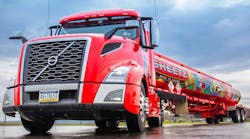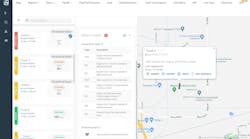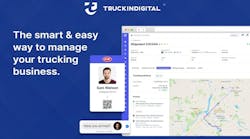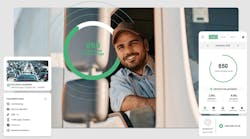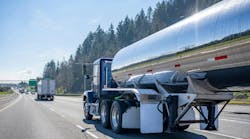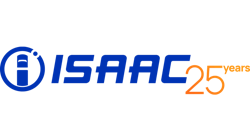IN 2014, the National Tank Truck Carriers (NTTC) launched the Liquid Products Database (LPD)—a cargo tank corrosion prevention initiative sponsored by NTTC and developed by Battelle. The product gets better by the day.
The LPD is a searchable, web-based product that puts cargo tank corrosion information at the fingertips of tank fleet managers. The initiative was driven by the persistent and damaging issue of corrosion and pitting of tanks, which was addressed during the 2013 NTTC Tank Truck Week in Houston, Texas.
NTTC organized a user panel to discuss the LPD during the association’s 69th Annual Conference held April 30 to May 2 in Chicago, Illinois. Panelists included: Bailey Glendenning, chief executive officer of Glendenning Brothers Inc; Ted Gorski Jr, president of Gorski Bulk Transport; and Kim Kaplan, president of K-Limited Carrier Ltd. Ryan Streblow, NTTC senior vice-president of sales & marketing, was the moderator.
Q: What is the estimated number of trailers you’ve seen over your career that have been, because of the product reaction, damaged or pitted?
Kaplan: We’ve probably had 10 to 15 trailers we’ve had to switch to non-code service. We do have customers we can put those trailers into, which helps keep the equipment in service. But we lost the full use of that equipment, so it became very apparent we needed to do something. We started to talk about the LPD in the NTTC chemical committee meetings several years ago. We thought it was extremely important because we didn’t want to continue to have that issue. We started by learning the system. But I am not there taking the orders and talking to customers and dispatching and selecting the equipment we’re going to load that on. But the primary function is that we want to educate our front-line folks that are taking those loads and make sure they understand what that product is. They’re not chemists. So we want to make the system work for them. We’ve also found that it’s been very beneficial to our customers to understand because our customer service rep is just taking that order and they have to dispatch it. So we thought it was extremely important that our front-line folks learned the system. We are taking one person in our dispatch operation and making him or her the person to be responsible, get the Safety Data Sheet, understand the makeup, look at those products individually, and understand exactly what that product is. If we don’t have the equipment or the right type of trailer, then we can’t do it. It’s a costly thing to not get a trailer utilized. I think everybody here can understand that.
Gorski: We have 180 trailers in our fleet now—maybe 15 or 20 tank trailers that had some pitting or were so extremely pitted they had to be downgraded to non-code. To try and control that, it’s important to have a process in place. In our business, we came up with a standardized format. It starts with the SDS and goes on to review the product and materials that are in that product. If we don’t have it in the SDS, we ask the customer for a technical data sheet to help us understand the handling and storage characteristics of the product. If it can’t be handled, we’re not moving it. We’d much rather have a disappointed customer than ruin an asset and create unnecessary cost for our business. From that standpoint, having a database and a way to make this information available across the industry and across all the people in the business is very important. When we first started, we had a simple typewritten sheet that a manufacturer rep shared with us. Over the years, we have collected other charts. But there was nothing that was a tool that could tell us what was susceptible to corrosion. That’s one of the nice things about the LPD. Even in it’s infancy, it has 4,000 products. It has that wealth of information and shows the corrosion rates for everybody to see.
Glendenning: Obviously, I have fewer years of experience in the industry. My understanding is that we’ve had a few trailers experience unexpected severe corrosion. I haven’t seen any of those, so it hasn’t happened in the past five years. But the challenge we face is it means one expert in our company who is always in the position of making the decision of, can you haul it or can you not? So as we bring in new staff, we have different people in dispatch or sales. Everyone is still reliant on my father on what we can and can’t haul. One of the benefits we’ve seen in the two months we’ve had access to the database is it’s geared directly toward our industry. So it’s not just the standard SDS that gives you information about a chemical. It actually gives it to you the context of how it affects the trailer. It’s relevant and makes sense to people who use it and takes some of the guesswork out. Our dispatchers and transportation managers have a bit more freedom in decision-making and more independence in the long run that’s very beneficial in trying to scale and grow the business.
Q: Can you elaborate on what the process was in your company prior to the LPD?
Kaplan: Back in the day of the Material Safety Data Sheet, we would review it and then we would talk to our customer or shipper and even say: “OK, this is what we’ve got. This is what components are in this. This is the trailer we have. Is it OK?” So we depended on our customer, because I’m not a chemist and there is no way I can determine what’s what and what would react with the trailer. So we either took the word of that customer that yes, it would not cause any tank issues, or we didn’t haul the load. So all of a sudden, dispatch started to do the same thing, but they weren’t asking a lot of those questions because we didn’t train them to do that. What we’re doing today with the LPD system is truly remarkable, and it will continue to be because of what we’ve done thus far. I think it’s almost 6,000 products in the database now, so it’s really growing, and I think it’s going to continue. We used to rely on other people telling us it was OK. And that’s not the way to do it. So we got a little more intel that the trailer would be damaged and we would start to determine from the customer if we should haul this. We would do some testing and send some of the products to our trailer manufacturers and they would do a corrosion test and let us know if we needed to have a different type of lining. It just took a long time.
Glendenning: It’s always been my dad. And he asked a ton of questions. But again, it limited us, and for a very long time we avoided things we maybe could have hauled because he wasn’t completely confident it wasn’t going to be a problem. We didn’t touch it. Nobody else could make a decision. Shippers don’t know or they give you general information. At least with this, you have a concentration. You have something to look at as a foundation.
Gorski: Twenty years ago, it was easy to get in touch with your shippers. Talk to somebody in customer service and say, “Tell me about this product,” and they knew that product inside and out. As times moved forward and we went through the downturn and the impact on our nation, a lot of that skill set vanished. So the people that you used to be able to rely on with the shippers and saying, “Yes, you can do that but you have to really wash that product within six hours or some corrosion will start forming”—that knowledge is gone. If we’re going to capture the information from the practical experience carriers have with the product and by engaging people to share the information they have with us and get it into a common database, that’s something that can be used and can be readily accessible and is an important part for our association. So carriers, the people we rely on, their talents are disappearing. This is our investment. We’re spending thousands and thousands of dollars on a tank trailer. You really don’t want to spend another $10,000 or $15,000 filling in thousands of pits in the tank. So it’s important to get the information, share it with NTTC and build something that’s robust for the next generation.
Q: As you’re talking about the shippers here, has there been a positive reaction from them as you’re utilizing the LPD platform and explaining to them the importance?
Kaplan: We’ve discussed it with a couple of our partners and shippers. At first they were like, “What are you talking about?” Then we finally got them to understand the need, and if we did need information from them, would they be willing to help us with the information? I think basically they see it as a positive impact because when we cannot service their account, it hurts our shippers as well. So I think it’s been a good circle of information for both of us. We explained the LPD and showed our customers the system and they thought it was tremendous. It’s something we hope to continue to grow and our partners and our carrier friends will continue to buy into it because it’s a good program.
Gorski: Our shippers have been delighted to help us. But again, it is something that remains carrier-driven because this is the product we’re putting in our tank trailers and you know the impact of it. You find the shippers that when they modify a product, they add salt to change the viscosity. Salt will start pitting and corrosion in the tank trailers. This is the information we have to share.
Glendenning: Thus far, after two months, we’ve had very limited conversations with our shippers. We’re kind of learning the system ourselves. But it’s encouraging to hear that everyone else’s shippers seem to be responding well. I think there’s a lot of opportunity for us. Hopefully it will help us to get better information and to educate them to some degree about what matters to us. The addition of salt is a minor change to them but could be a really significant change to us.
Q: For the carriers who currently don’t subscribe to the LPD, what would you share as the biggest benefit?
Kaplan: For the cost of being a member of the system, it’ll save you thousands of dollars in the long run. We need your input as much as what you’ve already got in there. To make us a better company and carrier and better partner to our customers, I think it would be very beneficial for you to look at it. It’s grown so much from when they started it several years ago to where it is today. It’s been amazing. It will continue to grow, but we need your help for that as well. I think you’d be extremely happy—and your equipment will be very happy.
Gorski: At the end of the day, when you have a tank trailer that you want to trade or reposition to other use, and someone tells you, “I’m sorry, that’s good for water storage and that’s about it because its heavily pitted,” your company leaves tens of thousands of dollars on the table. If that happens prematurely when the trailer has been in service for a year, it’s a huge cost. When that trailer is in the repair shop and is out of service two to four weeks, that’s a loss of efficiency. We have to preserve our assets and make sure they’re readily available. If we have the best processes in place, then we assure that the trailers can be used, cleaned, and returned to service without incident. If this saves hundreds of thousands of dollars across our carriers, it’s well worth it. Individually, it’s all our own investments. These are our trailers and we have to preserve them. We expect to see good service life out of every stainless steel tank trailer. I really don’t want to see it ended because of pitting in a very short period. So it’s important to watch. The LPD is a great tool in setting up a process.
Glendenning: Protecting the asset is the #1 thing. It’s critical. It’s essential. They’re expensive and we have to get the most out of them we possibly can. For us on the operational side, it’s just the sustainability. The LPD is a critical resource. There’s a ton of information specific to tank carriers, especially those of us running stainless steel equipment. ♦
